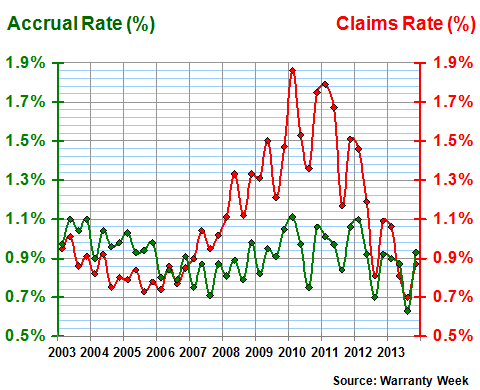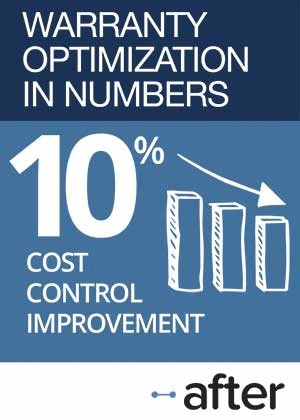Eleventh Annual Product Warranty Report:While some manufacturers are having trouble with product reliability, others are seeing their warranty expenses rise simply because they're selling more product than ever before. Case in point: the new holder of the title of world's largest warranty provider.
Warranty expenses continued to increase in 2013, with claims finally surpassing 2009 levels and accruals almost rising above 2008 levels. Now that most manufacturers have filed their last financial reports for 2013, it's clear that warranty costs overall are now rising a bit faster than product sales. But that's not necessarily a bad thing, if the extra money is being spent on improving the customer's experience rather than making up for lapses in product quality.
This week we're going to take an in-depth look at claims payments by U.S.-based manufacturers, splitting them up into three groups. A total of 230 companies fit into the category of "vehicle makers," which includes both aerospace and automotive. Another 668 companies fit into one of several "high-tech" categories, such as computers or medical equipment. And then 245 companies fit into one of the "building trades," appliances, furniture, new homes, building materials, etc.
We're also tracking an additional 82 companies that don't easily fit into one of these three categories -- everything from makers of watches and guns to companies supplying conveyor belts to fruit inspectors. We lump them together in the "other" category. And we track about 56 foreign companies that don't have to reveal their warranty expenses to the SEC but nevertheless do so. But since their annual reports don't generally come out until late spring or summer, we're not including them in our statistics today.
Four Warranty Metrics
From each company, we collect four essential warranty metrics: the amount of claims paid, the amount of accruals made, the balance in their warranty reserve funds, and the amount of product sales reported. We've been doing this every quarter since 2003, so we're now completing our eleventh year: 44 quarters of warranty data.
In Figure 1, we've displayed the annual totals for the three industry categories under the "vehicle maker" heading. As can be seen in the figures, the combined totals for the auto parts and auto OEMs has remained close to $10 million for the past two years, with the OEMs rising by about as much as the parts suppliers declined. The aerospace category, meanwhile, is at its highest level ever.
Figure 1
Worldwide Warranty Claims Payments
of U.S.-based Vehicle Makers
(claims paid in US$ millions, 2003-2013)
There was a mixed picture within the automotive OEMs, with some reporting sharply lower warranty expenses, and others reporting large increases. Among the largest automotive OEMs, General Motors scored the biggest decline in claims payments last year, while Navistar, Deere, and Paccar turned in the largest increases. Caterpillar, Ford and Terex paid out about as much in 2013 as they did in 2012. Overall, their totals rose by $202 million, from $8.486 billion in 2012 to $8.688 billion last year.
Annual Totals for 2013
Manufacturers traditionally file their annual reports with the U.S. Securities and Exchange Commission in late February and early March. Over the past few weeks, the last bunch of stragglers have filed their financial reports, which we've added into the totals and averages. We're now up to $26.3 billion in claims paid and $27.8 billion in accruals made in 2013, which represents growth of 6.6% and 10%, respectively, from 2012 levels. Product sales, meanwhile, rose only 5%, which means that warranty costs as a percentage of sales were up for the year.
A handful of companies such as Checkpoint Systems Inc. have filed late notices with the SEC, alerting the agency that they'll miss the deadline completely. But at this point, we've now heard from all U.S.-based warranty providers that reported making claims payments of $1 million or more in 2012, except for these 10 companies: Clean Diesel Technologies Inc.; Cyberoptics Corp.; Easton-Bell Sports Inc.; Euramax Holdings Inc.; GSE Systems Inc.; Iridex Corp.; Lighting Science Group Corp.; Plug Power Inc.; Stanadyne Corp.; and Stereotaxis Inc. When they finally do report, we would expect them to contribute an additional $20 to $25 million to the 2013 totals.
We plan in-depth reports on each of the industry categories in the weeks ahead. But on first look, some shocking surprises stick out from the statistics. For instance, while all the auto OEMs saw claims rise by a collective $201 million last year, just the bill paid by Navistar was up by $182 million.
The company is having a difficult time complying with the latest diesel engine emissions requirements of the U.S. Environmental Protection Agency and the California Air Resources Board. As the company stated in its annual report, " In 2010, we introduced changes to our engine line-up in response to 2010 emissions regulations. Component complexity and other related costs associated with meeting emissions standards have contributed to higher repair costs that exceeded those that we have historically experienced."
Therefore, the company is upwardly revising its estimates for the cost of warranties on the MaxxForce Big-Bore engines it sold in years past. It expected normal warranty costs, but experienced much higher-than-expected costs. So it is making up for its initially low estimates with additional accruals to make up for the shortfall.
Rewarding Miscalculations?
And here's where things get a bit tricky. We're not accountants, but the company is listing these "pre-existing warranty adjustments" as one-time expense items that are excluded from its calculations of EBITDA (earnings before interest, taxes, depreciation and amortization). This would seem to be rewarding miscalculations by making their corrections seem like unusual events. And these upward adjustments to cover "unexpected" expenses also aren't showing up in our calculations of the company's warranty expense rates, which are much lower than they would have been, had the company set aside enough funds when the products were sold.
It's not so much a criticism of Navistar as it is of the way these changes of estimate are processed. Here's how it works with normal claims and accruals: In the fiscal year ended October 31, 2013, Navistar reported $637 million in claims payments and $469 million in warranty accruals. With sales of manufactured products coming in at $10.6 billion, the company's claims rate works out to 0.637 / 10.6 = 6.0%, and its accrual rate was 0.469 / 10.6 = 4.4%.
However, in fiscal 2013 Navistar also set aside an additional $404 million in "pre-existing warranty adjustments," which are designed to correct for under-accruals in years past. The year before, it also set aside an additional $404 million (on top of its $571 million in current-year accruals) to correct its under-estimates of 2011 and 2010 warranty costs. But these corrections aren't current-year accruals, so they don't factor into the math for the "normal" current-year accrual rate calculations, as illustrated above.
So what we've done, to show the real impact of these adjustments, is to take Navistar's reported accruals for current-year sales, and its reported adjustments for previous-year sales, and add them together. In Figure 2, the red and green lines display the "normal" claims and accrual rates, while the blue line displays the new accrual rate that includes the adjustments.
Figure 2
Navistar International Corp.
Warranty Claims & Accrual Rates
With and Without Changes of Estimate
(as a % of product sales, 2003-2013)
A company that's setting aside seven or eight percent of its product revenue to pay for warranties is unlikely to be profitable. And in fact Navistar reported a net loss of $898 million in fiscal 2013, which is almost as much as the amount it set aside in warranty accruals and adjustments. Or to put it another way, the net loss per share ($11.17) is only slightly larger than the warranty cost per share ($10.86).
High-Tech Product Warranties
Now let's take a look at the seven industry categories we bundle under the heading of "high tech." Yes, there are seven categories in Figure 3, although in most years it's very hard to see the slice for consumer electronics. That's because except for the years 2007-2009, when the Microsoft Xbox 360 was breaking down at a record pace, not much happens in this industry sector in terms of warranty work.
Remember, all these companies are U.S.-based only, and most of the consumer electronics we buy are imported. Even within the gaming category, Sony and Nintendo are non-U.S.-based companies. So while they might pay warranty claims on that equipment, those payments aren't included in these charts. Microsoft, by the way, ceased reporting its warranty expenses in the middle of 2012, so it's also not included in the 2013 data.
However, there were big gains in claims paid by companies in two of the other categories -- computers and telecom equipment -- which led to an overall gain for the high-tech sector. Historically, these electronics companies have accounted for 35% or 36% of the claims paid by all U.S.-based manufacturers, while the vehicle makers have accounted for 48% or 49%. But in 2012, the high-tech share rose to 39%, and in 2013 it hit 41%. Meanwhile, the vehicle makers have fallen to 44% of the total claims paid.
Figure 3
Worldwide Warranty Claims Payments
of U.S.-based High-Tech Manufacturers
(claims paid in US$ millions, 2003-2013)
High-tech manufacturers paid out nearly $10.9 billion in claims last year, up from $9.6 billion in 2012. Most of that gain can be traced to just one company: Apple Inc. While Hewlett-Packard has seen declining sales and even faster declines in warranty costs, and while Dell has gone private and has therefore exited the list of reporting companies, Apple has rather quickly and quietly passed not only both of them, but also the top vehicle makers, to become the world's largest warranty provider.
Depending upon the year and the exchange rate, that title used to belong to either General Motors or Daimler AG. But in calendar 2013 (the second, third, and fourth quarters of Apple's last fiscal year and the first quarter of its current one), Apple paid out $4.08 billion in warranty claims and set aside $5.75 billion in warranty accruals, decisively taking the number one spot away from the carmakers.
In past years, GM has paid out more in claims than Apple did last year, but it has not done so since its bankruptcy in 2009. Ford has paid out more than $4 billion per year as well, but again, not since before the recession. And those are the only two American companies besides Apple to have ever paid out more than $4 billion in claims during a calendar year.
Rising Through the Ranks
In fact, when we first started compiling warranty claims payment statistics in 2003, Apple was forty-first on our list, behind AutoZone, Lennar, EMC, Gateway, Maxtor, Nortel, Trane and many others. By 2007, the year it launched the iPhone, Apple had climbed to seventeenth place, behind Paccar, Cummins, Deere, Cisco and others. By 2010, when it launched the first iPad, Apple was in sixth place. In 2011 and 2012 it remained in fourth, and then last year it took first.
In Figure 4, we've charted the claims payments of the current top five since 2003. Apple is in red. The data is quarterly, so what looks like a $3.1 billion level for 2013 is actually that figure times four, or $12.5 billion for the complete year. And yes, that means these five companies account for nearly half of all claims paid by U.S.-based companies.
Figure 4
Top Five Warranty Providers of 2013
Claims Paid per Year, 2003-2013
(Worldwide Spending, in US Dollars)
It's not a criticism of Apple; it's just a recognition of a change at the top of the list. The massive worldwide success of the iPhone and iPad also comes with a massive warranty bill. And of course, AppleCare is a massive extended warranty program on top of that. And despite all the trouble relatively new companies such as Tesla Motors are having at the state level while trying to compete with traditional dealers through direct sales, the Apple Stores are a massive direct sales channel for both the company's products and its protection plans.
Where Apple runs into the most trouble is outside the U.S., where some countries require two-year product warranties, which reduces the appeal of extended warranties. But Apple has by now largely settled with its international regulatory critics, which is one reason why its product warranty claims bills are rising. Longer warranties mean higher costs.
Product Warranties in the Building Trades
Finally, let's take a quick look at the building trades, which for us means anything that goes into a home or office building, including the appliances, the fixtures, the furniture, and the heating/cooling systems. It also includes the makers of power generating equipment, including not only the traditional diesel, nuclear, coal and gas-powered turbines and generators, but also the newer biomass, fuel cell, solar, and wind power systems.
While the vehicle and high-tech sectors have always accounted for the bulk of warranty expenses, these four categories within the building trades have always accounted for 14% to 16% of the total claims paid each year by all U.S. manufacturers. Right now their total is at the low end of that range, because as can be seen in Figure 5 they're still well below their peaks of six or seven years ago.
Figure 5
Worldwide Warranty Claims Payments
of U.S.-based Building Trade Companies
(claims paid in US$ millions, 2003-2013)
However, together these 245 companies paid out around $3.67 billion in claims last year, up by about $92 million from 2012 levels. And the homebuilders in particular have seen a healthy comeback in sales, which inevitably brings with it an increase in warranty expenses.
The power generation companies also have seen a noticeable jump in claims payments, but that's caused primarily by General Electric Co., which saw its claims bill rise from $723 million in 2012 to $814 million in 2013. By the way, GE has moved into sixth place, behind Caterpillar, now that Dell has gone private. Next year, the balance of the top ten will be filled out by the likes of Cisco, Navistar, John Deere, Cummins and Boeing, depending on where those companies rank in their 2014 claims payments.
Big Jump in Claims for Homebuilders
The new home builders as a group saw their claims payments jump by 12% to $336 million in 2013. Apple caused the big jump in the computer claims payments seen in Figure 3, while Boeing caused the big jump in the aerospace claims payments seen in Figure 1. No one homebuilder caused the big jump in claims seen in Figure 5, but as a group they all saw more sales, more repairs on those sales, and inevitably more warranty costs.
The good news is that the homebuilders have already squeezed all the costs they could out of their warranty programs. During the decline of 2006 to 2012, their annual claims payments fell during five of the six years. In Figure 6, what we want to show is that their warranty costs as a percentage of sales have also fallen, but not before skyrocketing during the deepest trough of the lean years.
Figure 6
U.S.-based New Home Builders
Average Warranty Claims & Accrual Rates
(as a % of product sales, 2003-2013)
The charts are highly seasonal, which comes as no surprise given the outdoor nature of homebuilding. But despite the fluctuations, one can see that from 2005 until early 2010, homebuilders saw their claims payments rise from about 0.7% to 0.8% of a home's selling price to almost 1.9%. Depending on the home's selling price, that means the companies were paying out somewhere between $2,000 and $2,500 per home in 2005, and between $4,000 and $4,500 per home in 2010. In other words, their warranty cost per home basically doubled in five years, even though average home prices actually declined.
Part of the reason was Chinese drywall, mold, leaks, and other maladies. But most of the reason was the nature of claims payments: you're basically fixing last year's sales with this year's money. And since new home sales were in free-fall during the recession, the claims rates soared.
At the same time, accrual rates didn't change much, because accruals are always made in proportion to sales. If you expect a new home's warranty to cost you $2,500, then every time you sell a home you should set aside $2,500 in accruals. If you sell no homes, you make no accruals. If sales double, so do accruals. The accrual rate would always be $2,500 per home sold. And so, for most of the past 11 years the accrual rate has remained a little above or a little below 0.9%.
Falling Average Claims Cost per Home
But then something amazing happened: In 2011, the average claims cost per home fell under $4,000. In 2012, it slipped under $3,000. Last year, the claims cost declined to around $2,700 or $2,800 per home sold. And with home prices once again rising, both the average claims rate and the average accrual rate fell to their lowest-ever levels during the third quarter of 2013. They rose again in the fourth quarter, but it's clear from the data in Figure 6 that we're still on the low side of the historical averages.
This fits in well with the theory outlined in last week's newsletter -- that we've come to the end of the warranty cost-cutting era. For homebuilders, at least, by last year there was little left to cut. And once those new lows had been reached, they could afford to pay out a little more per home, making their customers a little happier, or at least a little less unhappy.
We're not saying they're going to slip back into the old and inefficient patterns of behavior. But instead of practicing a routine of "deny, deny, deny" when faced with claims, now they can afford to generate a little more goodwill, pay a few more of the borderline claims, spend a little more on the workmanship, and let their warranty costs rise a bit, back to their historical one percent average.
|















